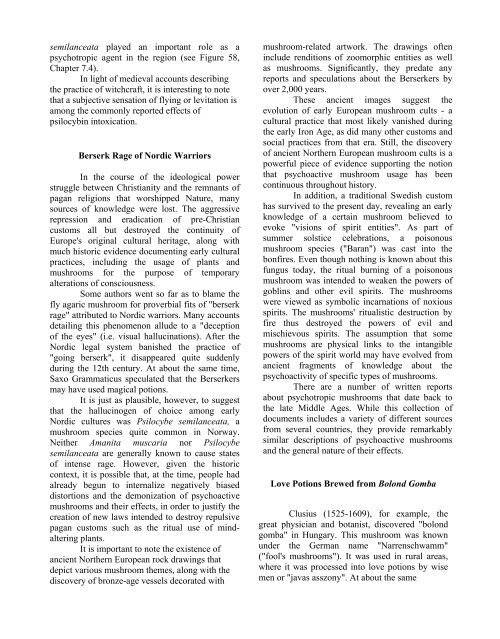Jochen Gartz - Magic Mushrooms Around the ... - preterhuman.net
Jochen Gartz - Magic Mushrooms Around the ... - preterhuman.net
Jochen Gartz - Magic Mushrooms Around the ... - preterhuman.net
You also want an ePaper? Increase the reach of your titles
YUMPU automatically turns print PDFs into web optimized ePapers that Google loves.
semilanceata played an important role as a<br />
psychotropic agent in <strong>the</strong> region (see Figure 58,<br />
Chapter 7.4).<br />
In light of medieval accounts describing<br />
<strong>the</strong> practice of witchcraft, it is interesting to note<br />
that a subjective sensation of flying or levitation is<br />
among <strong>the</strong> commonly reported effects of<br />
psilocybin intoxication.<br />
Berserk Rage of Nordic Warriors<br />
In <strong>the</strong> course of <strong>the</strong> ideological power<br />
struggle between Christianity and <strong>the</strong> remnants of<br />
pagan religions that worshipped Nature, many<br />
sources of knowledge were lost. The aggressive<br />
repression and eradication of pre-Christian<br />
customs all but destroyed <strong>the</strong> continuity of<br />
Europe's original cultural heritage, along with<br />
much historic evidence documenting early cultural<br />
practices, including <strong>the</strong> usage of plants and<br />
mushrooms for <strong>the</strong> purpose of temporary<br />
alterations of consciousness.<br />
Some authors went so far as to blame <strong>the</strong><br />
fly agaric mushroom for proverbial fits of "berserk<br />
rage" attributed to Nordic warriors. Many accounts<br />
detailing this phenomenon allude to a "deception<br />
of <strong>the</strong> eyes" (i.e. visual hallucinations). After <strong>the</strong><br />
Nordic legal system banished <strong>the</strong> practice of<br />
"going berserk", it disappeared quite suddenly<br />
during <strong>the</strong> 12th century. At about <strong>the</strong> same time,<br />
Saxo Grammaticus speculated that <strong>the</strong> Berserkers<br />
may have used magical potions.<br />
It is just as plausible, however, to suggest<br />
that <strong>the</strong> hallucinogen of choice among early<br />
Nordic cultures was Psilocybe semilanceata, a<br />
mushroom species quite common in Norway.<br />
Nei<strong>the</strong>r Amanita muscaria nor Psilocybe<br />
semilanceata are generally known to cause states<br />
of intense rage. However, given <strong>the</strong> historic<br />
context, it is possible that, at <strong>the</strong> time, people had<br />
already begun to internalize negatively biased<br />
distortions and <strong>the</strong> demonization of psychoactive<br />
mushrooms and <strong>the</strong>ir effects, in order to justify <strong>the</strong><br />
creation of new laws intended to destroy repulsive<br />
pagan customs such as <strong>the</strong> ritual use of mindaltering<br />
plants.<br />
It is important to note <strong>the</strong> existence of<br />
ancient Nor<strong>the</strong>rn European rock drawings that<br />
depict various mushroom <strong>the</strong>mes, along with <strong>the</strong><br />
discovery of bronze-age vessels decorated with<br />
mushroom-related artwork. The drawings often<br />
include renditions of zoomorphic entities as well<br />
as mushrooms. Significantly, <strong>the</strong>y predate any<br />
reports and speculations about <strong>the</strong> Berserkers by<br />
over 2,000 years.<br />
These ancient images suggest <strong>the</strong><br />
evolution of early European mushroom cults - a<br />
cultural practice that most likely vanished during<br />
<strong>the</strong> early Iron Age, as did many o<strong>the</strong>r customs and<br />
social practices from that era. Still, <strong>the</strong> discovery<br />
of ancient Nor<strong>the</strong>rn European mushroom cults is a<br />
powerful piece of evidence supporting <strong>the</strong> notion<br />
that psychoactive mushroom usage has been<br />
continuous throughout history.<br />
In addition, a traditional Swedish custom<br />
has survived to <strong>the</strong> present day, revealing an early<br />
knowledge of a certain mushroom believed to<br />
evoke "visions of spirit entities". As part of<br />
summer solstice celebrations, a poisonous<br />
mushroom species ("Baran") was cast into <strong>the</strong><br />
bonfires. Even though nothing is known about this<br />
fungus today, <strong>the</strong> ritual burning of a poisonous<br />
mushroom was intended to weaken <strong>the</strong> powers of<br />
goblins and o<strong>the</strong>r evil spirits. The mushrooms<br />
were viewed as symbolic incarnations of noxious<br />
spirits. The mushrooms' ritualistic destruction by<br />
fire thus destroyed <strong>the</strong> powers of evil and<br />
mischievous spirits. The assumption that some<br />
mushrooms are physical links to <strong>the</strong> intangible<br />
powers of <strong>the</strong> spirit world may have evolved from<br />
ancient fragments of knowledge about <strong>the</strong><br />
psychoactivity of specific types of mushrooms.<br />
There are a number of written reports<br />
about psychotropic mushrooms that date back to<br />
<strong>the</strong> late Middle Ages. While this collection of<br />
documents includes a variety of different sources<br />
from several countries, <strong>the</strong>y provide remarkably<br />
similar descriptions of psychoactive mushrooms<br />
and <strong>the</strong> general nature of <strong>the</strong>ir effects.<br />
Love Potions Brewed from Bolond Gomba<br />
Clusius (1525-1609), for example, <strong>the</strong><br />
great physician and botanist, discovered "bolond<br />
gomba" in Hungary. This mushroom was known<br />
under <strong>the</strong> German name "Narrenschwamm"<br />
("fool's mushrooms"). It was used in rural areas,<br />
where it was processed into love potions by wise<br />
men or "javas asszony". At about <strong>the</strong> same








![The Big Lie 9-11 and Government Complicity in Mass Murder [PDF]](https://img.yumpu.com/50957077/1/190x245/the-big-lie-9-11-and-government-complicity-in-mass-murder-pdf.jpg?quality=85)








